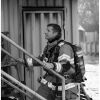Cancer reduction and mitigation has become a high priority for fire departments across the country.
We are all very aware of the research and staggering statistics that link our occupation to several cancers. In response, major industry manufactures have developed new technologies and initiatives to help reduce the risk to firefighters. This includes the improvements to or development of turnout gear, diesel exhaust capture systems, extractors and even skin wipes.
However, one of the largest developments has come from fire apparatus and apparatus equipment manufacturers through the promotion of the clean cab concept.
There isn’t a single set series of standards for a clean cab design. Generally, they include separate compartmentation for firefighting gear or equipment, and smooth, flat, non-porous interior surfaces to facilitate the removal of contaminants inside the apparatus’s cab.
The clean cab concept revolves around the principle that the dirtiest and most likely exposed or soiled equipment from a fire incident are totally isolated from the apparatus cab. These components are instead stored in exterior and/or sealed compartments.
There are some variable degrees of the clean cab concept. Some focus on removal of soiled turnout gear alone. Some focus on the removal of SCBA, permitting personnel to wear their clean turnout gear inside the apparatus cab (but storing in a separate compartment post-fire). Some include the removal of soiled equipment. The next level of the clean cab concept is the total removal anything that was exposed to toxins. The personnel will respond to emergencies in station uniforms, and then don the needed protective gear once on the scene.
These ideas are decided on by the organization’s leadership and then supported by policy or operational procedures.
Regardless of the option that works best for your department, one thing is for certain: We must take the appropriate actions needed to help reduce our members’ exposure to carcinogens – now.
So, what about the departments that are unable to purchase a new rig with a clean cab design and therefore have to work with existing apparatus? What are we doing to minimize our risks of exposure? For these departments, the best option is to focus on a “cleaner cab” or the cleanest cab that works for your department.
A cleaner cab, simply put, is taking mitigating actions to reduce personnel exposure by properly and proactively cleaning the interior of the apparatus cab and our firefighting equipment, as well as following a process that limits exposure to contaminated gear.
By stressing the importance of cleaning turnout gear – to include hoods and gloves – not only after fire incidents, but routinely, as some departments require the washing of turnout gear to occur quarterly or bi-annually in addition to exposures. Also, taking the time to thoroughly clean and wipe down firefighting equipment that is normally stored in the cab, too. This can include hand tools, flashlights, radios and the SCBAs we wear.
Are the interior surfaces of your apparatus regularly cleaned? Your department can take a proactive stance and establish a set day for your members to complete these preventative tasks. Once again, if the equipment we use is decontaminated, then its specific location inside or outside of our apparatus cab is irrelevant.
The most important aspect of the cleaner cab is to complete the needed decontamination for you personnel post-fire. The steps you take immediately after the event will drastically reduce the personal exposure to carcinogens, as well as the transfer of these contaminants into the apparatus cab.
There is a ton of information available as well as procedures currently implemented by agencies. If you are in need of more information regarding post-fire incident decontamination practices, please refer to “5 steps for gross decon post-fire.”
The cleaner cab philosophy would be to place the dirty gear and equipment in an exterior compartment, or at least sealed in a large plastic trash bag. Additionally, soiled firefighting equipment would be stored in the same fashion during transport back to the station. As mentioned, personnel will take the time to comprehensively decontaminate the equipment and apparatus interior prior to the next emergency.
The clean cab or cleaner cab will always be debated but both are lifesaving.



